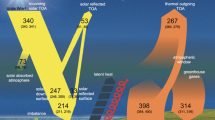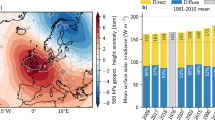Abstract
When the data sets that suggested record high UVI values at Mt Licancabur, and Laguna Blanca, Bolivia are reviewed in full, we find that the reported peak values are incorrect, probably due to instrumental problems. These affect the UVB, UVA and PAR channels at different times and different solar zenith angles, with distinct diurnal patterns in each case. The outliers are consistent with errors that would result from build-up of ice or snow on the surface of the entrance dome, combined with incomplete baffling of light within the integrating spheres that form the entrance optic of these instruments, but we cannot unequivocally attribute them to this cause. The analysis shows that for all three channels, cloud enhancements over clear-sky values by a factor of ~4 or more would be required to explain their highest values. Such repeated enhancements are not physically plausible and are more than twice those previously observed in the UV region. Further, at the time of peak reported UVB, the UVA cloud enhancement factor was less than 1.2 i.e., UVA radiation was increased by less than 20% over clear-sky values), which implies that to explain the high UVB values, an atmospheric ozone amount (~25 DU) far below the minimum ever observed would be required. The analysis also shows that the algorithm to convert from UVB to UVI is ncorrect, and that if the correct algorithm had been used, the peak UVI values would have been even larger than reported. Disregarding the obviously incorrect measurements, the highest realistic values near solar noon from this dataset are in the range UVI = 25 + 5, which is in agreement with previous estimates in the region
Similar content being viewed by others
References
N. A. Cabrol, U. Feister, D.-P. Hader, H. Piazena, E. A. Grin and A. Klein, Record solar UV. irradiance in the tropical Andes, Front. Environ. Sci. Eng., 2014, 2, 1.
R. McKenzie, G. Bernhard, S. Madronich and F. Zaratti, Comment on “Record solar UV irradiance in the tropical Andes, by Cabrol et al.”, Front. Environ. Sci Eng., 2015, 3, 26.
R. McKenzie, B. Liley and P. Disterhoft, Peak UV: Spectral contributions from cloud enhancements, in International Radiation Symposium, IRS, Auckland, NZ, 2016, DOI: 10.1063/1.4975570.
M. Iqbal, Prediction of hourly diffuse solar radiation from measured hourly global radiation on a horizontal surface, Sol. Energy, 1980, 24, 491–503.
R. L. McKenzie, P. V. Johnston and G. Seckmeyer, UV spectro-radiometry in the network for the detection of stratospheric change (NDSC), in Solar Ultraviolet Radiation. Modelling, Measurements and Effects, ed. C. S. Zerefos and A. F. Bais, Springer-Verlag, Berlin, 1997, vol. 1.52, pp. 279–287.
J. Lee-Taylor and S. Madronich, Calculation of actinic fluxes with a coupled atmosphere-snow radiative transfer model, J. Geophys. Res.:Atmos., 2002, 107, 4796.
G. E. Bodeker, J. C. Scott, K. Kreher and R. L. McKenzie, Global ozone trends in potential vorticity coordinates using TOMS. and GOME. intercompared against the Dobson network: 1978–1998, J. Geophys. Res., 2001, 106, 23029–23042.
G. Seckmeyer, A. Bais, G. Bernhard, M. Blumthaler, C. R. Booth, K. Lantz and R. L. McKenzie, Instruments to measure solar ultraviolet irradiance. Part 2: Broadband instruments measuring erythemally weighted solar irradiance, World Meteorological Organisation Report No., Geneva, 2008, p. 51.
R. McKenzie, D. Smale and M. Kotkamp, Relationship between UVB. and erythemally weighted radiation, Photochem. Photobiol. Sci., 2004, 3, 252–256.
G. E. Bodeker and R. L. McKenzie, An algorithm for inferring surface UV. irradiance including cloud effects, J. Appl. Meteorol, 1996, 35, 1860–1877.
T. B. Fitzpatrick, The validity and practicality of Sun-reactive skin types I. through VI, Arch. Dermatol, 1988, 124, 869–871.
M. L. Nack and A. E. S. Green, Influence of clouds, haze, and smog on the middle ultraviolet reaching the ground, Appl. Opt, 1974, 13, 2405–2415.
J. Badosa, J. Calbo, R. McKenzie, B. Liley, J.-A. Gonzalez, B. Forgan and C. N. Long, Two methods for retrieving UV. index for all cloud conditions from sky imager products or total SW. radiation measurements, Photochem. Photobiol, 2014, 90, 941–951.
J. Badosa, J. Wood, P. Blanc, C. N. Long, L. Vuilleumier, D. Demengel and M. Haeffelin, Solar irradiances measured using SPN1 radiometers: uncertainties and clues for development, Atmos. Meas. Tech., 2014, 7, 4267–4283.
J. Calbo, J.-A. Gonzalez, J. Badosa, R. McKenzie and B. Liley, How large and how long are uv and total radiation enhancements?, in International Radiation Symposium, IRS, Auckland, NZ, 2016, DOI: 10.1063/1.4975564.
G. Seckmeyer, B. Mayer, G. Bernhard, R. Erb, A. Albold, H. Jager and W. R. Stockwell, New maximum UV. irradiance levels observed in Central Europe, Atmos. Environ., 1997, 31, 2971–2976.
D.-R. Hader, M. Lebert, M. Schuster, L. del Ciampo, E. W. Helbling and R. McKenzie, ELDONET - a decade of monitoring solar radiation on five continents, Photochem. Photobiol, 2007, 83, 1–10.
J. B. Liley and R. L. McKenzie, Where on Earth has the highest UV?, in UV. Radiation and its Effects: an update, RSNZ. Miscellaneous Series, Dunedin, 2006, vol. 68, pp. 36–37, https://www.niwa.co.nz/sites/defauIt/fiIes/import/ attachments/LiIey_2.pdf.
U. Feister, N. Cabrol and D. Hader, UV Irradiance Enhancements by Scattering of Solar Radiation from Clouds, Atmosphere, 2015, 6, 1211–1228.
H. Winkler and J. Notholt, The chemistry of daytime sprite streamers - a model study, Atmos. Chem. Phys., 2014, 14, 3545–3556.
H. Winkler and J. Notholt, A model study of the plasma chemistry of stratospheric Blue Jets, J. Atmos. Sol-Terr. Phys., 2015, 122, 75–85.
E. Mishin, Ozone layer perturbation by a single blue jet, Geophys. Res. Lett, 1997, 24, 1919–1922.
J. A. Augustine, J. J. DeLuisi and C. N. Long, SURFRAD—A. National Surface Radiation Budget Network for Atmospheric Research, Bull. Am. Meteorol. Soc, 2000, 81, 2341–2357.
J. Grobner, G. Hiilsen, L. Vuilleumier, M. Blumthaler, J. M. Vilaplana, D. Walker and J. E. Gil, Report of the PMOD/WRC-COST. Calibration and Intercomparison of Erythemal radiometers Davos, Switzerland 28 JuIy-23 August 2006, PMOD, Davos, Switzerland, 2006, pp. 1–108.
R. R. Cordero, G. Seckmeyer, A. Damiani, S. Riechelmann, J. Rayas, F. Labbe and D. Laroze, World’s highest levels of surface UV: a case study, Photochem. Photobiol. Sci., 2014, 13, 70–81.
F. Zaratti, R. D. Piacentini, H. A. Guillen, S. H. Cabrera, J. B. Liley and R. L. McKenzie, Proposal for a modification of the UVI risk scale, Photochem. Photobiol. Sci., 2014, 13, 980–985.
F. Zaratti, R. N. Forno, J. Garcia Fuentes and M. F. Andrade, Erythemally weighted UV variations at two high altitude locations, J. Geophys. Res., 2003, 108(D9), 4263.
S. Madronich, Photodissociation in the atmosphere 1. Actinic flux and the effects of ground reflections and clouds, J. Geophys. Res., 1987, 92, 9740–9752.
Author information
Authors and Affiliations
Corresponding author
Additional information
Electronic supplementary information (ESI) available: Solar trajectories and horizons at each site. Plots showing time zone, differences in SZA due to incorrect location and time in C14. Plots of entire raw data for the entire data period, along with statistics for various flag settings, ozone amounts. Table to convert from UVB to UVEly. Daily plots of all data. See DOI: 10.1039/c7pp00089h
Rights and permissions
About this article
Cite this article
McKenzie, R.L., Liley, J.B. & Madronich, S. Critical appraisal of data used to infer record UVI. in the tropical andes. Photochem Photobiol Sci 16, 785–794 (2017). https://doi.org/10.1039/c7pp00089h
Received:
Accepted:
Published:
Issue Date:
DOI: https://doi.org/10.1039/c7pp00089h




